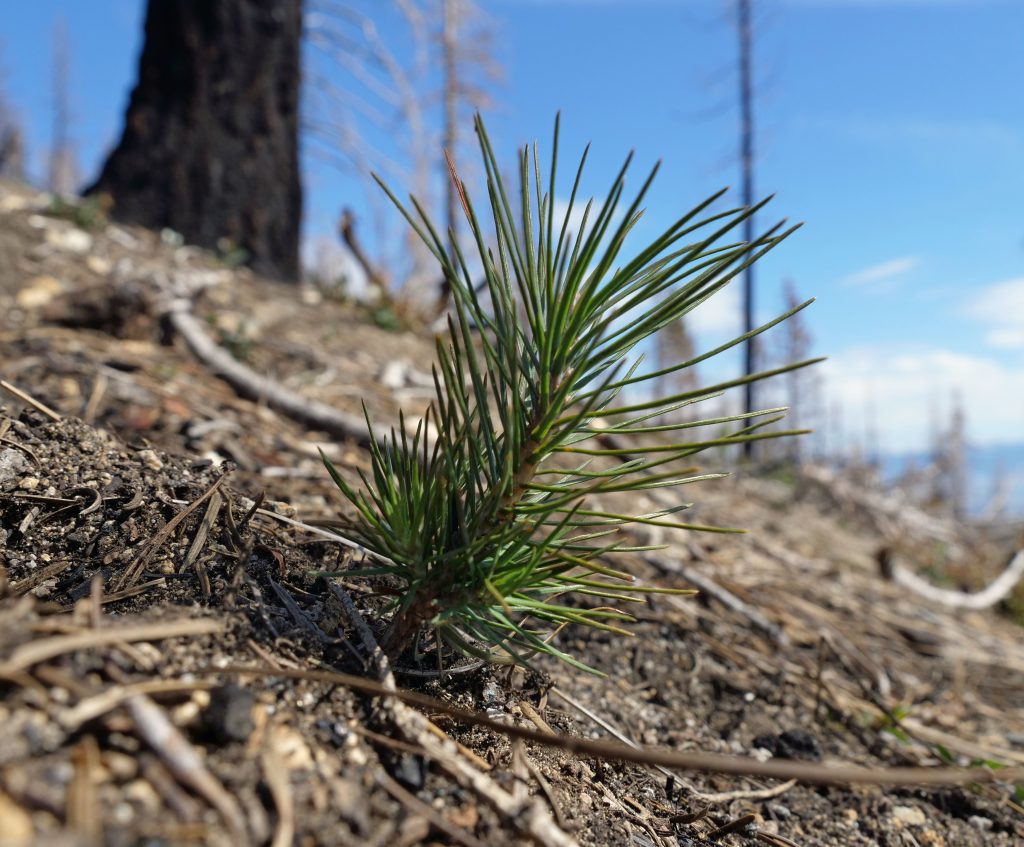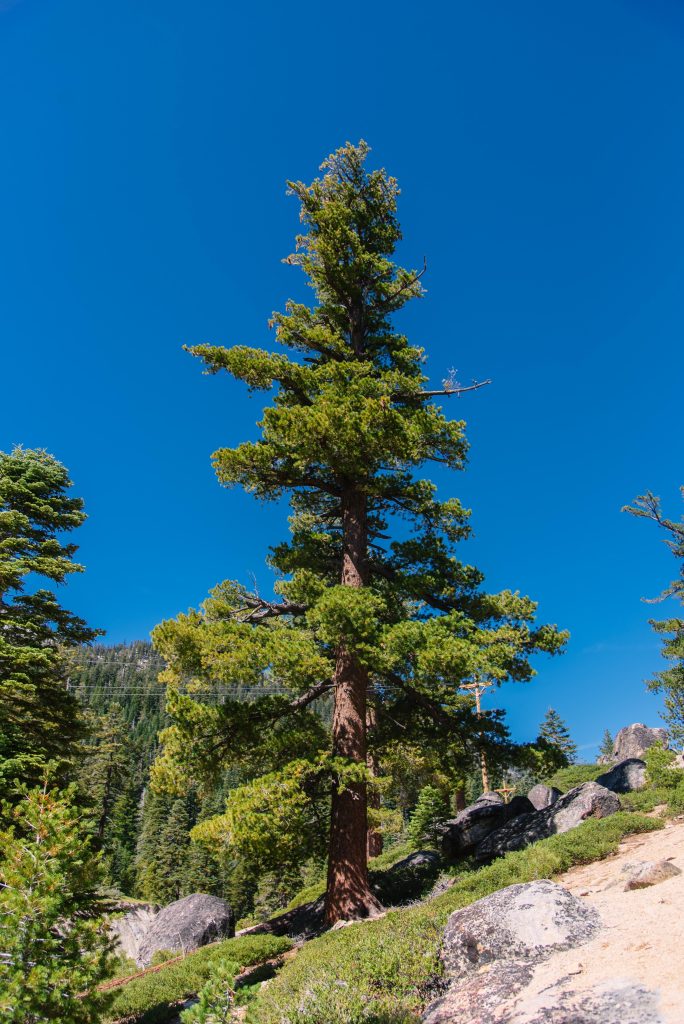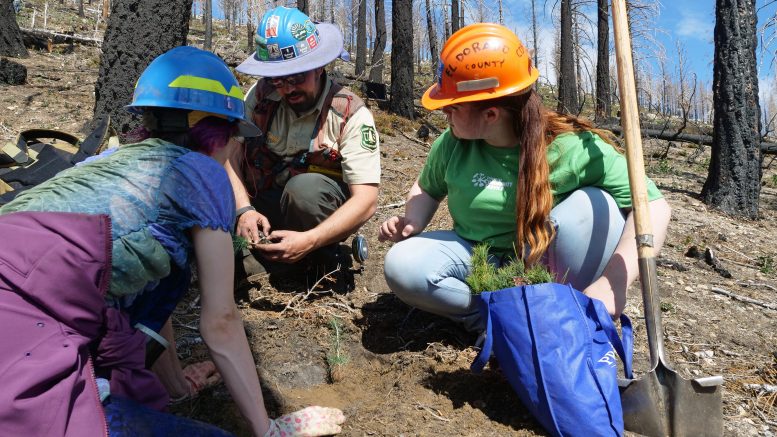From charred husks to so-called ‘zombie trees,’ northern California’s high elevations need healing now
By Ken Magri
As sunshine returns to the Sierra Nevada and the season’s record snowfall slowly melts away, volunteers help plant sugar pine seeds within the Caldor Fire burn scar along Highway 50.
Burrowing down into a foot of snow until reaching topsoil, each seed is covered up and its location marked for watering later in the season. The remaining snow will keep the seeds alive long enough to become seedlings, starting their new lives in a part of the forest that needs more conifers. The seeds can be purchased from organizations like the South Lake Tahoe-based Sugar Pine Foundation, ensuring they are for trees suitable to the area.
The evergreen tree canopy in the Sierra Nevada took a mighty hit during the 2021 Caldor Fire. In a burn scar measuring 222,000 acres across three counties, about 82,000 acres worth of trees were lost, according to Global Forest Watch. Without tree replanting efforts, the Caldor Fire burn scar could transition from forest into high chaparral and scrubland with smaller bushes and shrubs.
Besides wildfires, the Sierra’s trees have also been destroyed from disease and bark beetle infestations brought on by drought. Likewise, Earth’s warming temperatures make conditions too hot at lower elevations for some conifer trees to produce healthy seeds. Called “zombie trees,” these evergreens won’t reproduce because their climate is now mismatched with their environment. About 20% of the Sierra’s coniferous forests are “experiencing vegetative climate mismatch,” according to PNAS Nexus magazine from the National Academy of Sciences.
Several replanting efforts are underway, as government and nonprofit organizations team up with volunteers to find as many conifer seeds as possible, turn them into seedlings and get them into the ground in an ongoing effort to repopulate the Sierra.
“We’re not replanting all of the Caldor [burn scar] because it is too big,” says Maria Mircheva, executive director of the nonprofit Sugar Pine Foundation. “We work in key places where we want to bring the forest back and where there is good, safe access for volunteers to help us with this monumental and important task.”
Why is replanting so important?

One thing replanting does is preserve the beauty of California forests for tourism, which overall is estimated to be a $150 billion industry in 2023. Skiing, fishing and hiking in the Sierra — a region that covers 25 million acres — play an important part in the state’s tourist attractions.
Replanting also helps to sustain the earth itself. The massive root structures of trees stabilize the ground, prevent runoff erosion and protect the Sierra watershed more effectively than smaller shrubs. Shade from trees also cools the forest and provides sustenance for forest animals. Finally, replanting is important for fighting climate change, as the Sierra’s trees sequester carbon.
The Sugar Pine Foundation specializes in planting a single type of pine tree — the sugar pine. Once comprising 25% of Lake Tahoe’s forests, they are now dying from white pine blister rust, a non-native, invasive fungus (accidentally introduced at the turn of the 20th century by Canadian foresters) that weakens and kills cone-bearing branches.
These beautiful evergreens, the tallest in North America, can reach a height of 250 feet with long, sweeping branches holding seed-laden cones. But the Caldor Fire added to the destruction of the species. Sugar pines now make up less than 5% of Tahoe’s forests, according to the foundation.
But some sugar pines have a natural genetic resistance to the fungus. The foundation harvests cones every autumn from trees that have successfully resisted blister rust. Harvested seeds from these cones are planted during spring months in areas where they might have the most success surviving.
For the Caldor Fire scar area, the foundation is planting a mix of sugar pine, ponderosa pine, Douglas fir and incense cedar, totaling 75,000 seedlings on more than 250,000 acres in collaboration with the Eldorado National Forest.
The foundation needs volunteers to help with planting this spring, or with watering seedlings during summer months. While most planting events are near Lake Tahoe, the foundation has scheduled a replant on May 20 at Grizzly Flats, southeast of Placerville in El Dorado County. Grizzly Flats is where the Caldor Fire originated and did its worst damage, destroying more than 1,000 homes, essentially leveling the community.
Other replanting programs help

Replanting efforts throughout the Sierra are not confined to the work of the Sugar Pine Foundation. Among the oldest efforts is Penny Pines, a replanting project that began in 1941 by the San Francisco Sportswomens’ Association. Since then, other organizations have joined the program. The foundation asks for a $68 donation, which reflects the original 1941 cost for 1,000 pine seeds, enough to replant 1 acre of forest.
The Penny Pines Reforestation Program is now affiliated with the U.S. Department of Agriculture and the Forest Service. Over the decades, the organization’s efforts have planted more than 27 million seedlings, renewing 88,000 acres of national forest land in California.
Since 2014, One Tree Planted has planted over 92 million trees in 80 countries. This nonprofit also plants in the burn scars in California’s Coast and Sierra Nevada mountain ranges, and claims to be able to plant one tree for a dollar. Planting firs, cedars and dogwood trees helps to ensure the appropriate mix of forest species common to California. But this organization also plants sugar pines to fight the devastation of blister rust and bark beetles that eat the trees from inside.
The nonprofit American Forests, based in Washington, D.C., claims to have planted over 67 million trees in the last 30 years, and has pledged to plant 100 million more trees in large forest landscapes by 2030.
But replanting cannot happen without seedlings, and there is a shortage of seeds. “Simply put, we don’t have enough of them, or the people to collect them, or the nurseries to grow them,” says Brian Kittler, vice president of forest restoration for American Forests.
Because the extreme temperatures of recent wildfires kill off cone seeds, they become harder to find and harvest. American Forests co-created the Reforestation Pipeline Partnership with the Forest Service, the California Department of Forestry and Cal Fire to address the challenge of finding seeds. The idea emerged from a task force created by Gov. Gavin Newsom.
In its quest to find seeds, American Forests is looking for volunteers who can independently help increase the amounts of cones collected by acting as scouts and citizen scientists. Anyone who knows how to spot growing cones while out in nature can notify the organization about a specific location.
“The scale of wildfire destruction we’ve seen in the Sierra Nevada mountains over the past decade is massive,” says Britta Dyer, senior director of landscapes integration for American Forests. “This means we need an all hands on deck approach to reforest these lands.”
This story is part of the Solving Sacramento journalism collaborative. Solving Sacramento is supported by funding from the James Irvine Foundation and Solutions Journalism Network. Our partners include California Groundbreakers, Capital Public Radio, Outword, Russian America Media, Sacramento Business Journal, Sacramento News & Review, Sacramento Observer and Univision 19.



Be the first to comment on "Saving the Sierra: Volunteers can help repopulate lost conifers in the mountains "